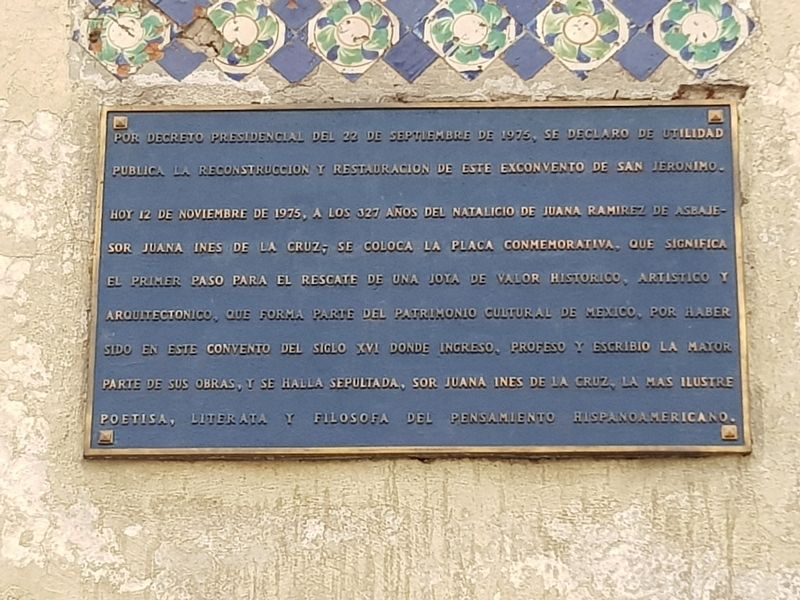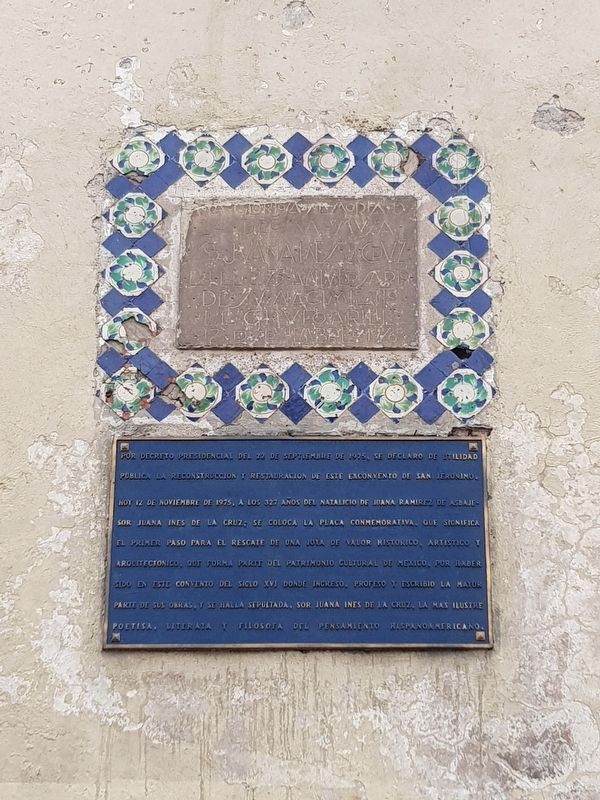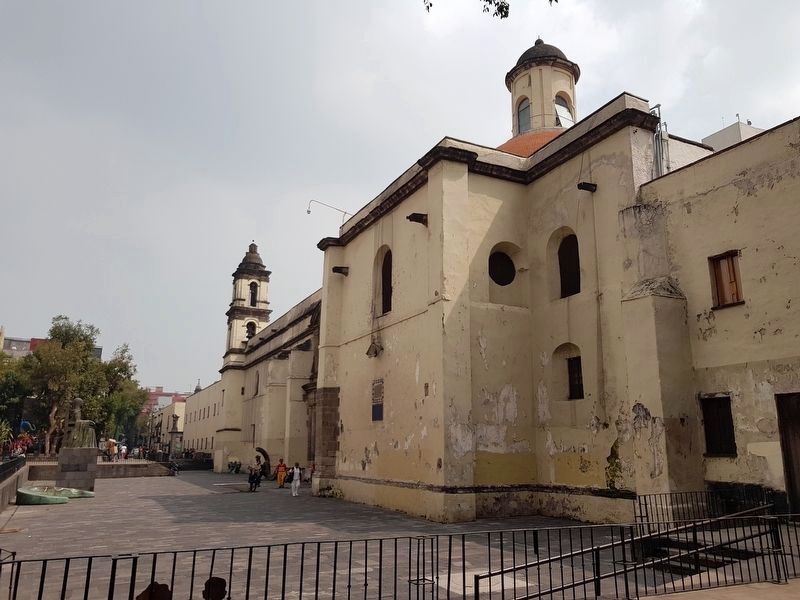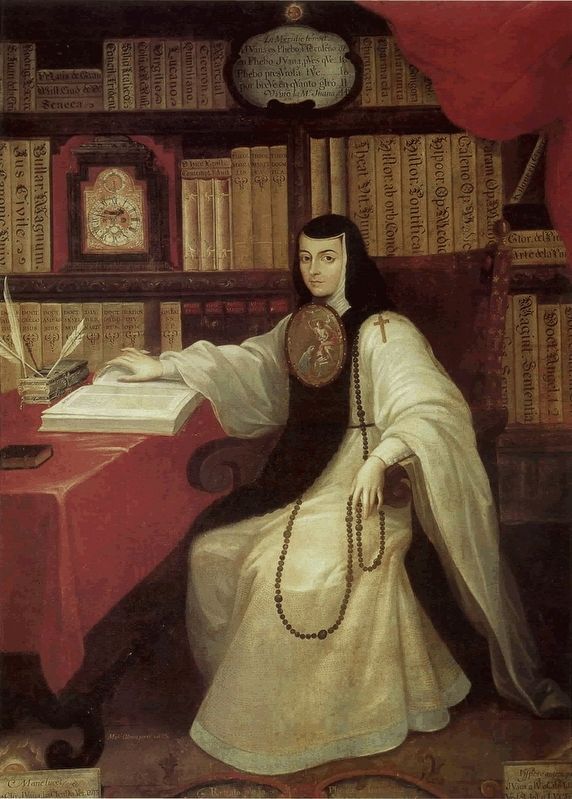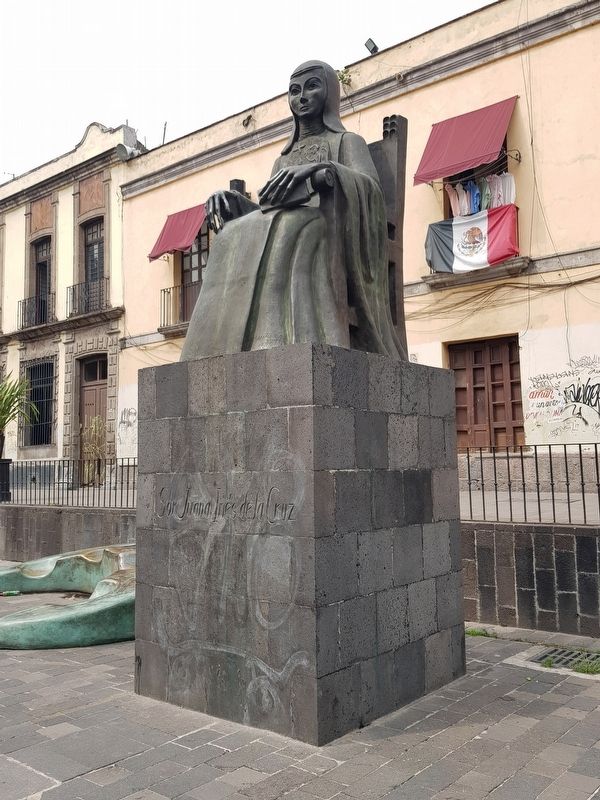Centro Histórico in Ciudad de México, Mexico — The Valley of Mexico (The Central Highlands)
Juana Inés de la Cruz
Por Decreto Presidencial del 22 de septiembre de 1975, se declaro de utilidad publica la reconstruccino y restauración de este Exconvento de San Jeronimo. Hoy 12 de noviembre de 1975, a los 327 años del natalicio de Juana Ramirez de Abaje – Sor Juan Ines de la Cruz; Se coloca la placa conmemorativa, que significa el primer paso para el rescate de una joya de valor histórico, artístico y arquitectónico, que forma parte del patrimonio cultural de Mexico, por haber sido en este convento del siglo XVI donde ingreso, profeso y escribió la mayor parte de sus obras, y se halla sepultada, Sor Juana Ines de la Cruz, la mas ilustre poetisa, literata y filosofa del pensamiento hispanoamericano.
By Presidential Decree of September 22, 1975, it was declared that the reconstruction and restoration of this, the Ex-Convento de San Jerónimo, is beneficial to the public good. Today, November 12, 1975, 327 years after the birth of Juana Ramírez de Abaje - Sister Juana Inés de la Cruz, this commemorative plaque is placed, which is the first step towards the rescue of a jewel of historical, artistic and architectural value, which is part of the cultural heritage of Mexico, for having been in this 16th century convent where she entered, professed her faith and wrote the majority of her works, and is buried - Sister Juana Inés de la Cruz, the most illustrious poet, author and philosopher of Latin-American thought.
Erected 1975.
Topics. This historical marker is listed in these topic lists: Arts, Letters, Music • Churches & Religion • Colonial Era. A significant historical date for this entry is September 22, 1975.
Location. 19° 25.614′ N, 99° 8.163′ W. Marker is in Ciudad de México. It is in Centro Histórico. Marker is on San Jerónimo just west of 5 de Febrero, on the left when traveling west. Calle San Jerónimo is pedestrian-only on this portion to the north of the Ex-Convent. Touch for map. Marker is in this post office area: Ciudad de México 06000, Mexico. Touch for directions.
Other nearby markers. At least 8 other markers are within walking distance of this marker. Daniel Cosio Villegas (about 120 meters away, measured in a direct line); San Jerónimo (about 150 meters away); Pulquería "La Risa" (about 180 meters away); "Paris" Pharmacy (about 180 meters away); Joaquin Noreña (about 210 meters away); The Printing Press of Antonio Espinosa (approx. 0.2 kilometers away); Temple of San Miguel Arcángel
(approx. 0.3 kilometers away); Concepción Béistegui Hospital (approx. 0.3 kilometers away). Touch for a list and map of all markers in Ciudad de México.
Also see . . . Juan de Inés Cruz. Juana Inés de la Cruz, O.S.H. (12 November 1648 – 17 April 1695), was a self-taught scholar and student of scientific thought, philosopher, composer, poet and nun of New Spain. She was a known as a nun who demonstrated the courage to challenge opinions and speak out for her beliefs. Her outspoken opinion granted her lifelong names such as, "The Tenth Muse", "The Phoenix of America", or the "Mexican Phoenix". Sor Juana lived during Mexico's colonial period, making her a contributor both to early Mexican literature as well as to the broader literature of the Spanish Golden Age. Beginning her studies at a young age, Sor Juana was fluent in Latin and also wrote in Náhuatl, and became known for her philosophy in her teens. Sister Juana educated herself in her own library, which was mostly inherited from her grandfather. After joining a nunnery in 1667, Sor Juana began writing poetry and prose dealing with such topics as love, feminism, and religion. Her criticism of misogyny and the hypocrisy of men led to her condemnation by the Bishop of Puebla, and in 1694 she was forced to
sell her collection of books and focus on charity towards the poor. She died the next year, having caught the plague while treating her fellow nuns. Adapted from Wikipedia. (Submitted on October 29, 2018, by J. Makali Bruton of Accra, Ghana.)
Credits. This page was last revised on April 17, 2020. It was originally submitted on October 29, 2018, by J. Makali Bruton of Accra, Ghana. This page has been viewed 180 times since then and 15 times this year. Photos: 1, 2, 3, 4, 5. submitted on October 29, 2018, by J. Makali Bruton of Accra, Ghana.
